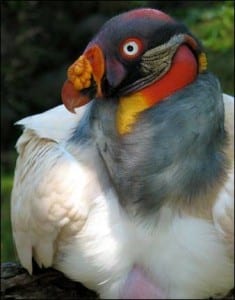Specimen of the Week: Week Thirty-Two
By Emma-Louise Nicholls, on 21 May 2012
 Burrowing around in a drawer last week, I discovered a fantastic looking skull with a curious labeling issue. Taxonomy of species changes all the time and some of our specimens go back at least to 1827. Ergo- not our fault. Is my point there. Anywho- it had the common name of one species, and the scientific name of another. I immediately embarked on a daring quest of skull comparative anatomy in a bid to uncover its true identity. So pleased am I by this fantastic specimen that I am immediately promoting it to SofW status (now with plaque), and telling you all about it so it will get lots of visitors and make lots of new friends. Accidentally carrying on the scavenging theme from last week’s Specimen of the Week, we are shifting from mammals to a different group within the animal kingdom. It’s big, it’s (very) bold, it’s (to some people) beautiful, this week’s Specimen of the Week is…
Burrowing around in a drawer last week, I discovered a fantastic looking skull with a curious labeling issue. Taxonomy of species changes all the time and some of our specimens go back at least to 1827. Ergo- not our fault. Is my point there. Anywho- it had the common name of one species, and the scientific name of another. I immediately embarked on a daring quest of skull comparative anatomy in a bid to uncover its true identity. So pleased am I by this fantastic specimen that I am immediately promoting it to SofW status (now with plaque), and telling you all about it so it will get lots of visitors and make lots of new friends. Accidentally carrying on the scavenging theme from last week’s Specimen of the Week, we are shifting from mammals to a different group within the animal kingdom. It’s big, it’s (very) bold, it’s (to some people) beautiful, this week’s Specimen of the Week is…
**!!!THE KING VULTURE!!!**
1) The king vulture is a New World vulture. Whilst both vultures look, well, like vultures, they are not that closely related. Although they are both in the Falconiformes, New World vultures occupy their own suborder. Old World vultures however, are in a separate group, together with hawks and eagles.
2) King vultures use their not inconsiderable 1.7 m wingspan to glide on air currents and look for carrion. Vultures provide an integral service by disposing of decaying remains that would otherwise spread disease. King vultures are pretty hard, they are one of the largest vulture species and have a very powerful beak. At a carcass, smaller birds typically step back when a king vulture arrives to feed.
3) The third thing you need to know about king vultures is that they are gorgeous. Their body and wings are black and white which contrasts exquisitely with their heads that are so multi-coloured, they’d make Joseph and his dreamcoat look drab. People often comment that vultures are ugly as they have bald heads but, in actual fact this is highly likely to keep them clean. Ever seen a guy with a big bushy beard, full of food? Not sexy.
4) Despite predators such as jaguars and snakes, King vultures nest on the ground. The female will lay a single egg but both parents take on the responsibility to incubate it. In the same way as the stars of Happy Feet feed their young, king vultures regurgitate food for their young.
5) King vultures inhabit swamps and forests of Central and South America, though they are now extinct in the most northern parts of their range. They still inhabit a vast area from Mexico down to Uruguay and Argentina, ranging from the east coast across the continent to the edge of the Andean mountain range.
6) A bonus not-really-science- fact is, some have suggested that the king vulture’s s name originated within Mayan society. Kings, or lords were thought to be able to carry messages between humans and gods. Given their size and wingspan, this makes sense, though personally, knowing a little about Mayan culture, I believe it is more likely to to do with their bright colouration.
2 Responses to “Specimen of the Week: Week Thirty-Two”
- 1
 Close
Close





I thought that the study which had shown that the Cathartidae were closely related to the Ciconiiformes had been retracted?
Admittedly bird taxonomy seems to be full of “we don’t really know”s (cf. Falconiformes possibly being closer to the Passeriformes and Psittaciformes than the Accipitriformes). It’s like trying to find a monophyletic needle in a poly- and paraphyletic haystack.
Of course, the ten year old in me is disappointed that parrots aren’t polyphyletic… ;o)